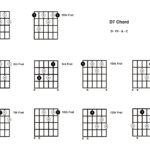Learning the guitar fretboard can feel like deciphering a secret code for many aspiring guitarists. Understanding where each note lies is fundamental to mastering scales, chords, and ultimately, expressing yourself musically on the instrument. A Guitar Notes Chart is an invaluable tool in this journey, acting as your visual roadmap to navigate the neck with confidence.
The fretboard diagram presented here simplifies this learning process. Whether you’re just starting out or exploring different tunings, this interactive chart is designed to make visualizing guitar notes intuitive and engaging.
Demystifying the Guitar Fretboard: Reading Your Guitar Notes Chart
The fretboard chart is oriented as if you were holding a guitar, with the thickest string (low E) at the bottom and the thinnest string (high E) at the top. The numbers along the bottom indicate the fret numbers, starting from the nut (fret 0) upwards. The 12th fret is highlighted as it marks the octave – a crucial landmark on the fretboard where notes repeat at a higher pitch.
For guitars in standard tuning (E A D G B E), the chart clearly displays the note at each fret position. This visual representation is key to understanding the relationships between notes and how they are organized across the fretboard.
Exploring Various Tunings: Adapting Your Guitar Notes Chart
One of the powerful features of this chart is its adaptability to different guitar tunings. Beyond standard tuning, many genres and playing styles utilize alternative tunings to achieve unique sounds and voicings. This guitar notes chart supports several popular tunings, including:
- DADGAD: Known for its open and resonant sound, often used in folk and Celtic music.
- Drop D: Lowering the 6th string to D creates a heavier, more powerful sound, popular in rock and metal.
- Open G: Tuning to G-D-G-B-D creates an open chord and is widely used in blues and slide guitar.
- Drop C: Lowering all strings by two semitones and dropping the 6th string further to C, common in heavier styles of music.
- Double Drop D: Dropping both the 6th and 1st strings to D, offering a wider bass range.
- Open C: Tuning to C-G-C-G-C-E creates a bright and resonant open chord, used in various genres.
By selecting a different tuning from the dropdown menu, the guitar notes chart instantly updates, showing you the note positions for that specific tuning. This eliminates the guesswork and allows you to explore new sonic territories with ease.
Interactive Learning: Features of the Guitar Notes Chart
This isn’t just a static diagram; it’s an interactive learning tool designed to enhance your understanding and ear training:
- Note Highlighting: You can select individual notes (E, A, D, G, B) to highlight them across the entire fretboard. This is incredibly useful for visually identifying all occurrences of a specific note.
- Scale Highlighting: Choose a scale, and the chart will highlight all the notes within that scale on the fretboard. This is a fantastic way to visualize scale patterns and understand their construction.
- Auditory Feedback: Click on any note on the fretboard, and you’ll hear its sound played through virtual guitar samples (electric, acoustic, or nylon). This auditory reinforcement connects the visual representation with the actual sound of each note, accelerating your learning process.
- Left-Handed Mode: For left-handed players, simply toggle the switch to flip the fretboard, providing a comfortable and accurate visualization.
Why Use a Guitar Notes Chart? Benefits for Guitar Players
A guitar notes chart is more than just a reference; it’s a fundamental tool that offers numerous benefits for guitarists of all levels:
- Accelerated Note Learning: Visualizing the fretboard with a chart makes memorizing note positions significantly faster and more intuitive than rote learning.
- Understanding Fretboard Logic: The chart reveals the logical layout of notes, helping you see patterns and relationships across the fretboard.
- Exploring Different Tunings: Easily adapt to and understand alternative tunings, opening up new musical possibilities.
- Scale and Chord Visualization: Use the chart to visualize scales and chords, understanding their construction and how they relate to the fretboard.
- Improved Improvisation: Knowing the notes on the fretboard empowers you to improvise more freely and confidently.
- Enhanced Communication: A shared understanding of fretboard notes facilitates communication with other musicians.
Conclusion: Your Fretboard Mastery Starts Here
Mastering the guitar fretboard is a journey, and a guitar notes chart is an essential companion for that journey. This interactive tool provides a dynamic and engaging way to visualize notes, explore tunings, and ultimately unlock the full potential of your guitar playing. Start exploring the chart today and take the first step towards fretboard fluency!
For further exploration and to enhance your guitar learning experience, be sure to check out our other helpful tools: guitar scales, guitar chords, online tuner, and tuning chart. And for bass and ukulele players, we have dedicated fretboard resources as well: bass fretboard and ukulele fretboard.


